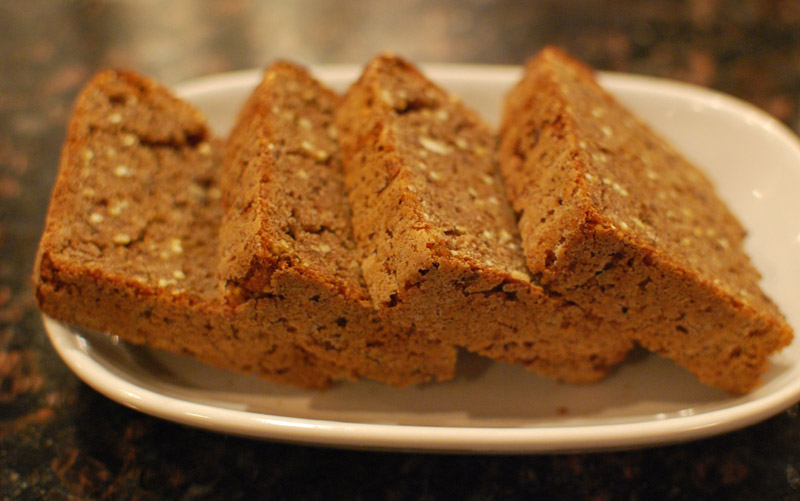Week Forty-One: German Breads
The last bread for this week is one of those very dense, rectangular loaves that, outside of Germany, often comprises the only example on grocery shelves of that country’s wealth of bread. Yes, Germany has other more familiar breads to offer, but I would be remiss to exclude one of this type, as popular as they are in their homeland.
Generally, this style of bread is made with any number of whole grains, which may or may not be ground into flour. Grains such as rye or buckwheat, more commonly grown in bygone days than wheat, don’t make good bread, due to their inability to produce a stable gluten network. But when treated a certain way — with a long, hydrating turn as a starter, followed by a low and slow baking process — these grains can produce a loaf that is just as delicious, if very dissimilar, to an airy wheat-flour bread.
Perhaps the most important ingredient here is patience. These are not breads that are quick to make in the slightest. The related Westphalian pumpernickel that I made earlier this year took a whole 4 1/2 hours to bake (after a 24 hour rest); today’s vollkornbrot (literally, “whole grain bread”) takes a mere hour and a half, but afterwards you are not allowed to touch it for 2 to 3 days. Yes, days. This extremely long rest gives the grains ample time to settle into themselves, the flavors to mature, and the hydration to even out.
As for the result… well, let me first say that I meddled with the original recipe. Not that the bread turned out badly; actually, I rather liked it. But I don’t think I can fairly gauge this one, considering the changes I made. Most crucially, where the original recipe called for cracked rye (which I didn’t have), I used coarse bulgur, whole flax seed, and millet instead. Hey, it’s all whole grains, right? Right?
*sigh*
Well, long story short, my hydration levels were off. My dough was very slack (couldn’t knead it if I tried), and the final dough was, predictably, rather gummy. Despite the unfortunate texture (which was luckily alleviated by toasting a slice), the flavor was quite good. It was complex and deep, but with no hint of the burnt flavor that so many of this sort of bread take on. It’s a rich, grainy, robust, and earthy combination; now I’m rather dying to try the unadulterated original version.
I know some of you are asking the same question that’s been plaguing me: what happens if you cut it early? Honestly, I haven’t a clue; I didn’t dare risk it. Curious as I was (and am), I wasn’t about to stake the entire loaf on the impatience of a moment. But if you simply can’t resist, and slice that bread early, do let me know what happens, okay?
Vollkornbrot
Adapted from Apple Pie, Patis, & Pâté
Makes one 9 x 5 inch loaf
For the starter:
8 ounces (1 1/2 cups plus 1/3 cup) pumpernickel (dark rye) flour
1/8 teaspoon instant yeast
1 cup cold water
For the soaker:
3 ounces (1/2 cup) coarse bulgur wheat
2 ounces (1/3 cup) millet
2 ounces (1/3 cup) whole flaxseed
10 ounces water
For the final dough:
7 ounces (1 3/4 cups) pumpernickel (dark rye) flour
1 3/4 teaspoons salt
1 teaspoon instant yeast
1/4 cup water
1. To make the starter, whisk the flour and yeast together. Add the water, and whisk until thoroughly combined. Cover loosely with plastic wrap, and let stand at room temperature for 14 to 16 hours.
2. To make the soaker, stir all ingredients together until combined. Cover tightly with plastic wrap, and let sit at room temperature for 14 to 16 hours.
3. To make the final dough, whisk the flour, salt, and yeast together in the bowl of a stand mixer. Add the water and all of the starter. Using the dough hook, mix at low speed until combined, about 2 minutes. Add the soaker and continue mixing for 10 minutes. Meanwhile, grease a 9 x 5 inch loaf pan. Dust with a spoonful of flour, knocking around to coat thoroughly. Rap the bottom of the pan, turned upside down, to remove any excess flour.
4. Scrape the dough into the prepared pan, smoothing the top. Cover loosely with plastic wrap, and let sit at room temperature for 1 hour, or until slightly risen and puffy. Preheat the oven to 475º F.
5. Tent the pan with aluminum foil, sealing it tightly around the edge, to trap steam. Bake the bread covered for 15 minutes at 475º F. After 15 minutes, remove the aluminum foil, lower the temperature to 375º F, and continue baking for another 60 minutes. After 60 minutes, remove the bread from the loaf pan, and immediately place onto a sheet pan. Return to the oven, and bake for another 15 minutes.
6. Transfer the bread to a wire rack to cool thoroughly. After cooling, wrap the loaf in a kitchen towel (not terry cloth) and store at cool room temperature for 48 to 72 hours before slicing.
Notes:
1. Vollkornbrot will keep for several weeks wrapped in plastic and refrigerated.


Pingback: Collard Green Soup and Sauerkraut Vollkornbrot